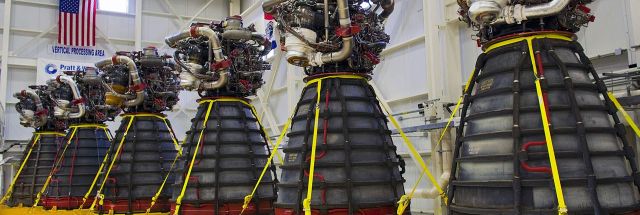
Six of the 18 reusable space shuttle engines NASA has in storage. Each is used once by the SLS missile and then discarded.
NASA
Last week, NASA official Jim Free appeared before the Aeronautics and Space Engineering Board and Space Studies Board in Washington, DC. There are many of these review committees that act as outside observers to NASA’s space policies and provide advice from seasoned hands. Free spoke about the agency’s Artemis program to return humans to the moon.
He made some news with his comments, saying publicly for the first time what is common knowledge in the space industry: the Artemis III mission, the first to take humans to the lunar surface since Apollo, will not take place in 2025. Free, according to Space News, said he had some “concerns” about the viability of the 2025 launch date. Well, a more realistic launch target for Artemis III is probably 2028-ish.
It’s all well and good for Free to acknowledge the likelihood of a delay. But it was his assignment of blame for the delay that raised some eyebrows. Free pinned the scheme to SpaceX, which is developing the big Starship rocket to serve, in part, as a human landing system to take astronauts from lunar orbit and back to the surface. SpaceX has an extensive test program to demonstrate Starship’s ability to launch and land, as well as to transfer and store propellant while in orbit. And free is correct; they have a lot of work to do.
“That’s a lot of launches to get those missions done,” Free said. “They still have a significant number of launches to go, and of course that worries me about the December 2025 date” for Artemis III. “With the difficulties SpaceX has had, I think that’s really concerning,” Free added.
Curiously, Free also questioned the value of the contracting mechanism NASA used to hire SpaceX and its Starship lander. “The fact is, if they don’t fly at the time they said, there’s no point in having a fixed-price contract, except we don’t pay more,” he said.
This comment was questioned inside and outside NASA. It may indicate some inner dissatisfaction at the space agency with the recent shift to a commercial contract model, where NASA generally pays a fixed price and buys services. This trend began with cargo and crew flights to the International Space Station and has since expanded to other areas, including the crew lander for the Artemis program and new spacesuits.
Cost-plus kind of sucks
Let’s take a step back for a moment and consider the absurdity of blaming SpaceX and its fixed-price contract for the Artemis delays. There are several key components involved in a lunar mission. There’s the big rocket to get the crew off Earth. For now, that’s the Space Launch System rocket, developed by NASA using cost-plus contracts. Then there’s the spacecraft they drive to and from the lunar orbit within Orion, also funded by cost-plus contracts. The lander is the final piece of hardware and is just as complex as the other two, as it must lift off from the lunar surface without any launch infrastructure and serve as a temporary habitat.
NASA selected Lockheed Martin as Orion’s prime contractor in 2006, and the agency has been funding the program at an average of about $1 billion a year for the past decade. Orion should finally fly a crewed mission in early 2025, after literally two decades of development.
Five years later, in 2011, NASA completed the design of the Space Launch System rocket. However, the space agency has been funding related work since 2007 from the rocket’s prime contractor, Boeing. NASA has spent an average of nearly $3 billion a year developing this SLS rocket over the past decade.

